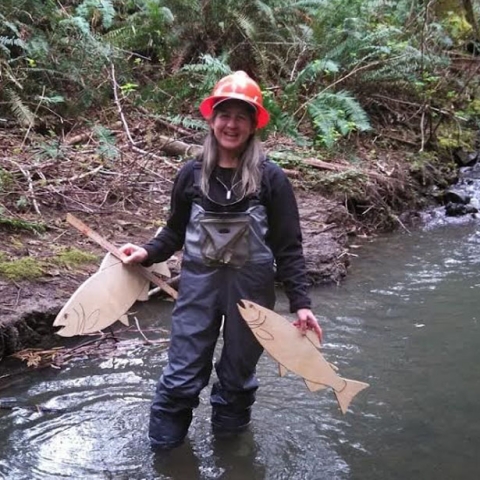May182016
Posted at 10:47 AM
This following originally appeared on the NOAA Fisheries Blog
In celebration of World Fish Migration Day 2016, NOAA Fisheries has highlighted the career path of an engineer working on innovative solutions to barriers that block anadromous fish from moving upstream to spawning grounds and downstream to the ocean. An anadromous fish, born in fresh water, spends most of its life in the sea and returns to fresh water to spawn. Salmon, smelt, shad, striped bass, and sturgeon are common examples. NOAA's engineers also work with partners and industry to develop best management practices that promote the recovery and sustainability of anadromous fish species. Their work is often at the cutting-edge of technology, promoting both ecologically-sound solutions while balancing economic viability.
Following is an interview with Margaret Tauzer, an engineer in the Region's Arcata, CA, office.
Why did you choose a career as an engineer?
I didn’t really set out to become an engineer working on fish passage projects. I was interested in writing but quickly found that I liked and excelled best in more quantitative-type classes. I grew up on a ranch and spent a lot of time in the relatively undisturbed outdoors, so natural resources and engineering was a good fit for me.
What was your education path?
I first started college at U.C. Santa Cruz just when Sally Ride was preparing to go into space, so naturally I wanted to study physics as she did. I ended up transferring to Humboldt State University where I took a few environmental resources engineering classes and became interested in hydropower systems. I took all the math, physics, and chemistry courses required and graduated with a Bachelor of Science degree in Environmental Resources Engineering.
After working as an engineer at Hydrocomp Inc., a hydrologic modeling consulting firm for about eight years, I attended Colorado State University where I received a Master’s of Science Degree in Civil Engineering with an emphasis in River Mechanics and Water Resources.
What is your current title and role at NOAA Fisheries?
My official job title is “Hydrologist” but I provide both hydrologic and engineering support for NOAA Fisheries’ restoration projects in the northern California area. My work ensures threatened and endangered salmon are able to migrate freely to and from their spawning grounds. I also work closely with some of our partner agencies, such as California Department of Fish & Wildlife. I conduct engineering reviews of projects and proposals for restoration grant programs, fish passage, and stream restoration projects.
What is the best part of your job?
The best part of my job is when I am working with a team to find the most ecologically-sound solutions for the species we are protecting and recovering.
What is the most challenging part of your job?
The most challenging part of my job is trying to juggle all of my projects. There is a significant workload associated with restoration and fish passage projects in northern California, and it’s important that my work is technically-sound and timely. My goal is to get the projects on the ground as quickly as possible.
What work accomplishment makes you most proud?
I think my best accomplishment so far is providing gravel extraction recommendations to our gravel team that will protect stream morphology for several local rivers that endangered and threatened salmon depend upon. This involved setting limits to gravel extraction based on water year intensity, designing fish channels that would prevent stranding of fish during their early fall migration, and trench designs.
What are your hobbies outside of work?
I spend a lot of my time working on our family ranch. The rest of my free time I spend both mountain and road biking.

